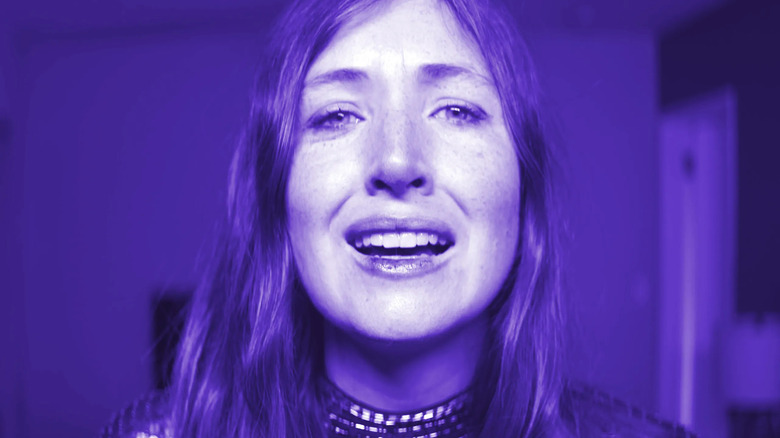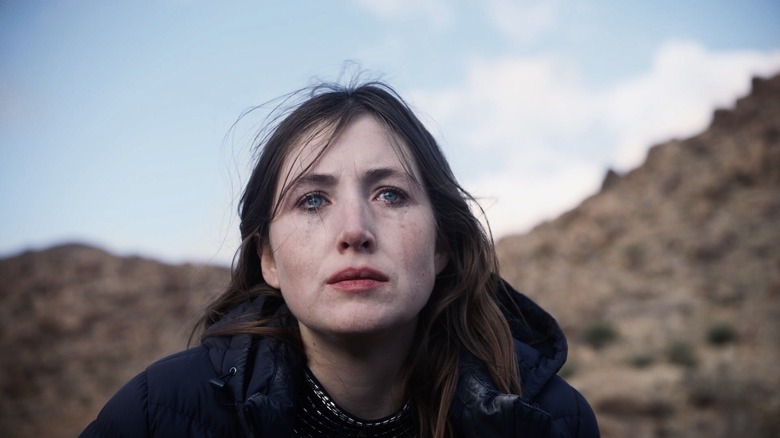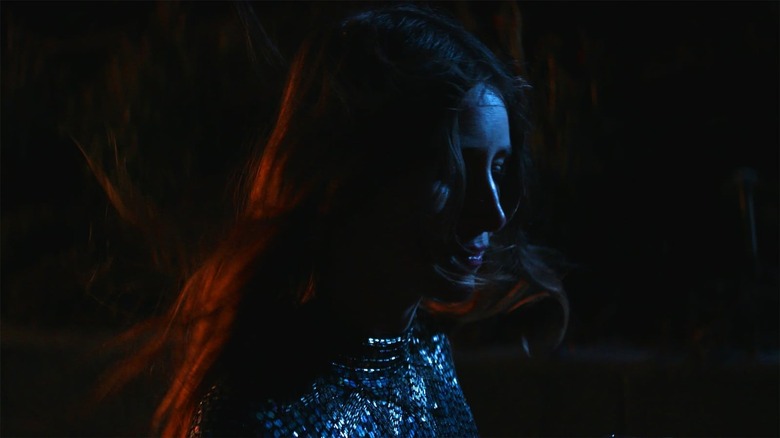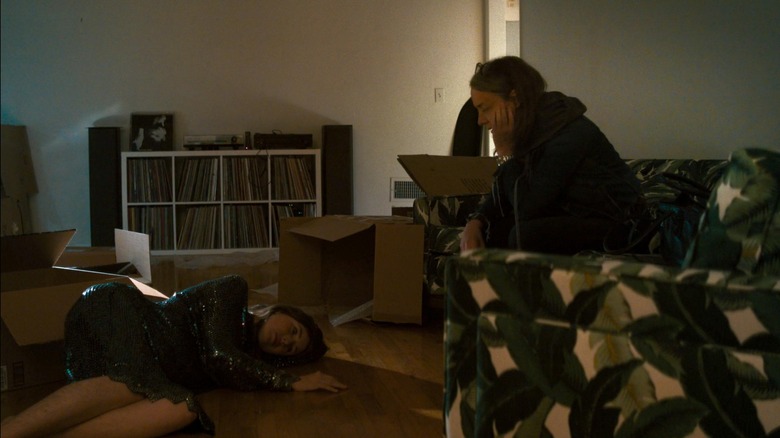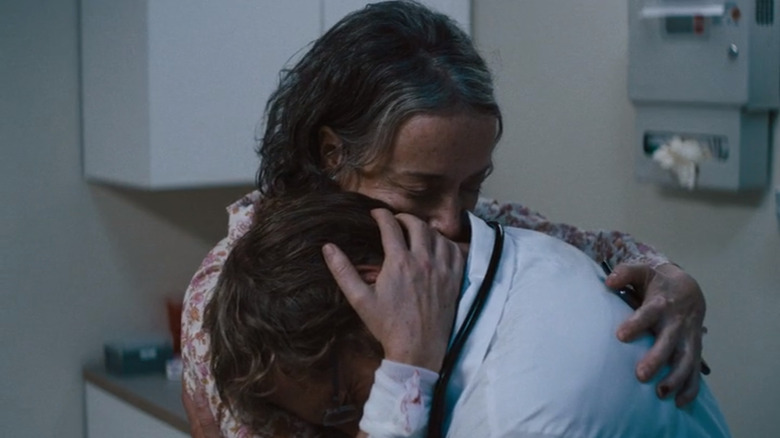She Dies Tomorrow Ending Explained: Contagious Despair
In an interview with Film Comment in 2020, actress/writer/director Amy Seimetz said that she used her ample salary from making the remake of "Pet Sematary" to make her feature directorial debut "She Dies Tomorrow," a dark fable about the nature of despair. "She Dies Tomorrow" was one of the unlucky 2020 features whose potential success was hindered by COVID-19-related theater closures, resulting in a combined box office take of less than $400,000 from a release on only 24 screens.
Not that a film like "She Dies Tomorrow" was a threat to, say, a Marvel film. Seimetz constructed an assertively sad meditation full of weeping, doubt, death, and fear. It imagines a world where depression is contagious and how humans' natural propensity toward utter emotional emptiness ultimately informs and colors every aspect of our lives.
The premise seems simple: Kate Lyn Sheil plays a woman named Amy who has just purchased a home and who should be in a happy place. She is a recovering alcoholic, but there's nothing in the story to suggest she's relapsed. When her friend Jane (Jane Adams) comes over to say hello, Amy announces that she is going to die tomorrow. She says when she dies, she wants her body to be made into a leather jacket so that something positive comes from her life.
Amy is not suicidal, necessarily. She doesn't announce that she intends to commit any acts of self-harm. Nor is she fearful of being hunted and killed by some outside force. She is merely convinced — convinced — that she will die tomorrow. When one is convinced they will die, one's behavior changes.
Then, later that night, Jane goes to a party and begins to experience similar symptoms ...
What you need to remember about the plot of She Dies Tomorrow
The "despair virus" begins to spread to others from there. Jane's brother Jason (Chris Messina) and his wife Susan (Katie Aselton) also become convinced that they, too, will die tomorrow. The world appears to be slowly entering into a state of worldwide self-mourning. We are doomed, there's nothing we can do about it, and there are no ways to alleviate the sadness. All the "infected" can really do is lay on the floor, think about what cannot or has not been done, and wait for the inevitable.
No one rages against the dying of the light in "She Dies Tomorrow." Their emotional beings are stripped of everything but fear and sadness. The story drifts from one person to the next, often forgetting about characters for extended periods. Two of the party guests clearly catch the sadness, and go to a hospital the next morning to confront a dying relative ... and to break up. Jane visits a doctor's office and the doctor (Josh Lucas) catches the sadness and leaves the office to be with his wife. Amy, having drifted out into the desert, meets a dune buggy driver (Adam Wingard, director of "The Guest" and "Godzilla vs. Kong"). The two attempt a sexual tryst, but they both lose interest.
Jane is a microbiologist of some kind and has begun talking to the microscopic life forms in her slides. There is a moment when it sounds like something has broken into her house. To kill her, perhaps? "Is this how it ends?" she asks. "She Dies Tomorrow" cleverly and honestly presents the spreading sadness as a matter-of-fact facet of the world. There is no supernatural explanation, no biological source. This is free-floating near-apocalyptic despondency.
What happened at the end of She Dies Tomorrow?
"She Dies Tomorrow" ends as downbeat as it begins. The Amy character, still convinced that the end of her life is nigh, wanders into a stranger's house. Two women (Michelle Rodriguez and Olivia Taylor Dudley) sunbathe in the back, also convinced that they will die soon. They discuss the things they will miss. In this moment, the characters achieve a grim level of peace. Amy then goes to a leather shop to look into her plan about being transformed into a jacket. As the proprietor describes the way hide is manufactured, Amy wakes up. Was she dreaming? She was outdoors, laying on some rocks. She whispers to herself that she's okay. Then that she's not okay. The film ends there.
You're not okay. I'm not okay. And that's ... okay.
In the Film Comment interview, Seimetz said that she was inspired to make "She Dies Tomorrow" after she also purchased her own first home ... and didn't feel intensely about the experience. She was inspired to make a movie about a woman whose disconnection with the world was presented as ineffable and incurable. The more Seimetz thought about disconnection, the more she realized that it was a guiding principle in the modern human experience. She even recalled a conversation she had with Steven Soderbergh who felt the same way. She recalls the filmmaker saying something akin to "You know, that's all life is. We have these conversations, we talk about what our day was like, and then you f***ing die." Seimetz loved that.
What does the ending mean? Let's look.
The cruelest joke is that we die
Anyone who has suffered from severe depression likely knows the weirdly comforting experience of finding someone or something that directly reflects your own sadness. Depression leads the mind down dark paths. Depression, almost an invasive entity, convinces its host that they are worthless, that human endeavors are pointless, and that one's decay and oblivion are the best for everyone. "She Dies Tomorrow," then, serves as a handshake. It's eye contact with the abyss inside the viewer. And it's the weird, comforting understanding that stems from that recognition. Sadness has recognizable textures, varied textures, that the filmmakers want to look at. To that point, Seimetz said:
"All Jane really wanted was for somebody to validate her feelings throughout the whole movie, and then suddenly it's these strangers that are like, 'Yeah, we're dying,' and she's like, 'Thank you.' When I describe the way that I direct things in terms of a narrative arc, I always go back to what a tantrum feels like, where it's the ramp-up to the tantrum, the complete outburst of emotion, and then that weird calm that happens after the storm. It's almost so quiet because it's gotten so loud, and this follows that format. We already went crazy and we're still here — now what do we do?"
The final lines of "She Dies Tomorrow," Seimetz said, reflected a massive "I'm okay, I'm not okay" that she saw storming through humanity. It was a mere coincidence that so many lives were shaken by COVID-19 when Seimetz's film was released. Anyone who says "I'm okay," she felt, isn't okay.
"She Dies Tomorrow" is about the nuanced geography — the color wheel of moods — surrounding one's mind when they're not okay.
What has the cast and crew of She Dies Tomorrow said about the ending?
Seimetz compared "She Dies Tomorrow" to both Agnès Varda's 1962 classic "Cléo from 5 to 7" and Steve Miner's 1981 classic "Friday the 13th Part 2." The former is about the two-hour span of a woman's life when she awaits the results from a medical test that could let her know whether she is terminally ill or completely well. In the latter, a woods-dwelling serial killer with a bag over his head murders counselors at a summer camp in New Jersey. Comparison to the former may make logical sense; how does one behave when they feel that death could very well be imminent?
The latter has more to do with "She Dies Tomorrow" than one might initially assume. When faced with Jason Voorhees, one is faced instantly with mortality. That sort of split-second contemplation brings fear, but also a weird exhilaration. Seimetz said:
"You only see Jason once with a bag over his head, but it's terrifying! That's how I kept describing it to everyone on set. What I was trying to elicit [from actors] is not just fear and terror, but also this rush of every single emotion — your body getting flooded 100%. Whatever they describe death as: all of your hormones releasing into your body, and you have euphoria and happiness and sadness and fear and everything."
"She Dies Tomorrow," one of the best films of 2020, is currently available to watch on Hulu and on Kanopy.
